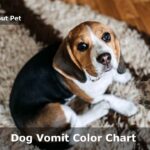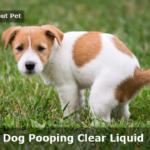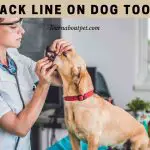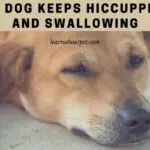There are several ways to check a dog’s health. In addition to seeing the body condition, you can check their behavior, appetite, and stool color. It’s not hard to see if there’s an oddity in the dog’s behavior or how they react to food. Beginner canine owners should learn the signs of an unhealthy dog by the different colors of their stools.
One of the unhealthy dog stool conditions is yellow balls in dog poop. There are several possibilities for a dog’s stool and yellow balls at some point. It could be because the dog has eaten yellow, hard-to-digest food, has intestinal worms, foreign objects, or parasite eggs.
To find out some of the primary causes of yellow balls in dogs’ stools, let’s read this article.

What Does Unhealthy Dog Poop Look Like?
Dog’s stool is not solid, mushy, loose, and smells bad. There are many types of unhealthy dog stool colors, such as gray, orange, red, black, and yellow.
Some stool colors are harmless if you know the cause. The white or green color is the result of what the dog eats. Green is probably caused by eating grass, and white from eating a lot of calcium like bones.
If you see small round yellow balls in the stool, check what your dog ate last time. If their menu is yellow, there’s a chance the food is difficult to digest and is intact with the yellow color. Your dog can eat sweetcorn or seeds.
What Does Yellow Dots In Dog Poop Mean?
The usual stool color is brown with a solid shape, and the odor is not so strong. If you see tiny yellow balls in dog poop, something has happened to your dog. Pay attention to some possibilities of your dog eating food that is difficult to digest or foreign objects such as toys or tools.
If you find a toy or item that is damaged and has yellow shards, your dog may have accidentally swallowed it, causing small yellow balls in dog poop.
The form of the foreign object will remain because it cannot be digested. Check the stool for blood spots because sharp foreign objects can cause internal injuries.
Yellow balls in dog poop are not to be taken lightly. If there’s nothing wrong with their diet, or there’s nothing your dog is eating, it could be because of parasites or worms.
The presence of worms in the dog’s stomach can go undetected. You can check with the vet every few months to eradicate any worms lodged in your dog’s body.
Why Does My Dog’s Poop Have Yellow Spots?
Did you give your dog corn or a yellow meal? If so, maybe the corn is not digested properly and comes out intact. Corn will look like yellow balls in stools. Sometimes it can be more than one seed if your dog swallows several corn kernels at a time.
If your dog is given an alternative diet, the color of its stools will be a lighter shade of brown. It is a sign your dog is adjusting to a new diet, even though there are no round yellow balls in dog poop, but regular solid poop.
Should I Worry About Yellow Balls In Dog Poop?
A brown or slightly brown color with a solid build is the only sign your dog is healthy. Sometimes dogs have a green or white stool color because they eat with the menu in the same color, but the shape is still solid. If you see yellow fat balls in the stool, try to poke them and guess what the yellow one is.
If the yellow balls move and look like worms, you need to be concerned about your dog’s condition. If the worms are allowed to continue to grow in the dog’s stomach, then other symptoms will follow, such as lethargy, weight loss, chronic soft stools, and hair loss.
Day by day, your dog will not want to eat more, and his condition will get worse. Yellow balls in dog poop should be treated immediately by bringing the dog to the vet for a medical examination.
Why Does My Dogs Stool Have A Pea Sized Ball In It?
The closest thing to a pea-sized ball is corn. Check in the last day or two whether the dog ate the corn you gave him or if they took it from the garden or played outside. Poke the yellow pea-sized balls in the stool, and ensure it is undigested food.
If the balls look suspicious because they move slightly like parasites or worms, take your dog to the vet immediately for a deworming process.
Dog Has Yellow Balls In Poop – What Should I Do?
Passing yellow balls in a stool is not a difficult thing if the shape of the yellow balls is small and does not bother your dog. Corn or foreign objects can come out along with the stool without having to make your dog whining or in pain after pooping.
It’s best to take your dog to the vet and ask what makes your dog have yellow balls in dog poop. You can tell the chronology of the past few days such as what your dog did, their diet menu, and what symptoms were shown other than the yellow stool.

Yellow Dog Poop Pancreatitis
This is different from little yellow balls in dog poop because the color of the whole poop turns orange or reddish. It is a sign that your dog has liver disease or other severe diseases. The closer to the color of blood, the more severe the disease suffered by your dog.
The main sign of pancreatitis is a greasy stool with a foul odor. Dogs showing signs of any pancreatitis should be taken to the vet immediately before it gets worse. Dogs must be treated intensively, and 48 hours of the initial onset of pancreatitis is critical to the dog’s life.
What Do Parasites Look Like In A Dog’s Poop?
The general color is white, although sometimes it looks like little yellow balls in a poop. If the dog’s stool is a little muggy with a strong odor, check the stool by breaking it down to see if there are worms.
The shape is like white cotton thread or tiny yellow balls. Yellow balls in dog poop will become commonplace if it’s obvious it’s undigested food. But you need to be observant to see if there are worms or not in the yellow color because pinworms are one type of worm that are difficult to see directly.
Tapeworm Eggs In Dog Poop
You can see tapeworms near the dog’s anus in the shape of hard yellow specks or pieces of rice. Any worms that come out with the stool will look like a piece of spaghetti with a slightly yellowish color.
The shape of the worms is different from the corn-like objects in dog stool. If the corn is solid, the tapeworm eggs will look mushy and not as big as the corn.
Yellow balls in dog poop can be a sign your dog needs to deworm and rid himself of all kinds of parasites. Give antibiotics if needed, because worms can inhibit your dog’s growth.
How To Prevent Yellow Balls In Dog Poop?
Sometimes you will deal with hard yellow balls in dog poop, or soft and yellow specks. The table below identifies steps to take when your dog has unhealthy poop.
| How to prevent | Explanation |
| Close eye on your dogs when they playing outside | Dogs sometimes get out of control in the park or in the yard. Watch what they approach and eat. |
| Give food with a yellow color with refined preparations | Giving corn kernels will make it difficult for your dog to digest them thoroughly. Mash corn kernels or make a mixture of other foods and vegetables. |
| Regular medical check-ups | The more often you take your dog to the vet, the easier it will be for the vet to advise on your dog’s health. |
Final Verdict – Yellow Balls In Dog Poop
Yellow color on a dog’s stool is not a beautiful sign for your dog. There are several possibilities, including the dog eating corn or undigested tools, getting liver disease, or the presence of parasites or worms.

The thing to worry about is that your dog is exposed to worms. If not treated quickly, the worms will multiply quickly, and your dog will experience other symptoms.
Take him to the vet for antibiotics, and keep away from places where there are lots of worms around your dog. Always check the condition of your dog’s stool, until the color returns to brown with a solid shape.
As a pet lover, make sure to learn about pet more and give your pet dog a good and comfortable life!

Welcome to Learn About Pet. My name is Rajkumar Ravichandran and I love all pets, travel, and amazing food. I write about my passion and personal experience caring for multiple pets in this blog! ❤️
Post Disclaimer
DISCLAIMER: THIS BLOG OR WEBSITE, "Learn About Pet", DOES NOT PROVIDE YOU WITH MEDICAL ADVICE AND IS NOT A SUBSTITUTE FOR MEDICAL ADVICE. ALWAYS GET IN TOUCH WITH YOUR PERSONAL VETERINARIAN AND USE INFORMATION HERE AS GENERAL ADVICE.
The information, including but not limited to, text, graphics, images and other material contained on this website are for informational purposes only. No material on this site is intended to be a substitute for professional veterinary advice, food recommendation, diagnosis, or treatment. Always seek the advice of your veterinarian or other qualified health care provider with any questions you may have regarding a medical condition or for pet food related questions.







